Exclusive ride on Britain’s answer to the new generation American sportcustoms
British bike builder Nick Gale is way too young to remember the Swingin’ 60s Rockers and their stripped out café racer specials bearing iconic names like Triton, Tribsa, Norvin and Dresda, who hung out at the famed Ace Café formerly just half a mile from his Nick Gale Custom Cycles/NGCC shop on London’s North Circular Road [see history sidebar].
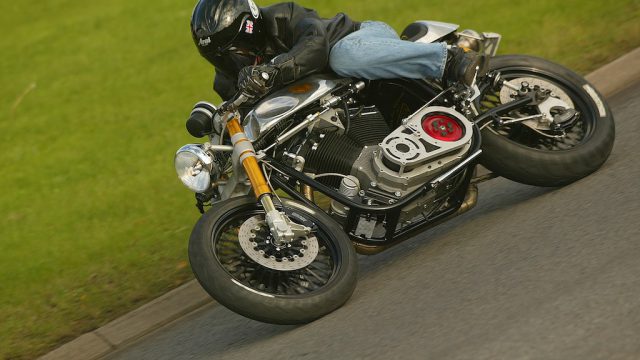
Sadly, NGCC closed its doors in September 2014 as yet another victim of the global downturn – but one of its boss’s most glorious creations is ready to be remembered as the Ace Café prepares to celebrate its 80th birthday in 2018. For Mark Wilsmore and George Tsuchnikas, the owners of the revived Ace Caff, agreed to let Gale build the bike with the Ace name and hallowed badge attached to it.
You can also read: Suzuki GSX-R1000R vs BMW S1000RR video review
Tips for going off-road on a big adventure bike
But Gale wanted to provide a British take on the current generation of Custom cruisers created by the likes of Roland Sands and Jesse Rooke, leaders of the new wave of motorcycle artisans made famous around the world via TV programmes like Discovery Channel’s Biker Build-Off. These men build the maddest, gnarliest, sportiest Custom bikes on the planet, dynamically functional while full of glitz and still looking way cool, replete with upside down forks, massive brakes, multi-pot calipers and seriously bad attitude, each one ready to carve corners and reach the front wheel to the stars, rather than simply function as a two-wheeled oil painting. Nick Gale wanted to join them – but instead of building a California-style 21st century Custom Superbike, he was going to do it his way, the British way, with the Ace Café Racer. “I saw very little point in trying to out-radicalise Roland,” says Gale. “I realised I could very easily come unstuck. So I needed to raise my game in a different way and do my own thing, which is why I chose the Café Racer.”

Nick Gale has serious form as one of Europe’s leading custom designers and top bike builders, winning Best in Show at major Custom events from Ireland to Italy, Spain to Germany, France to the UK, beginning with the acclaimed Memphis Belle he built in 2004, a heavily reworked Heritage Softail Harley which went on to win more than 60 show awards all over Europe, and has been followed by many other award-winning creations since then.
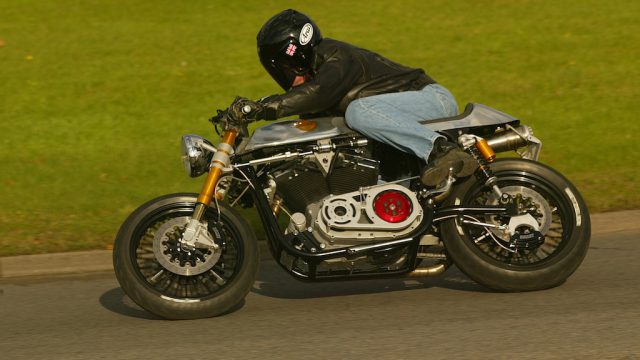
Having taken the decision to build the Ace Café Racer, Gale started off with a very simple brief. It had to have all of the characteristics of the Triton, which was the archetype ‘60s café racer, with a twin-cylinder Triumph engine in a Norton Featherbed frame. That meant it must have a Featherbed chassis fitted with clipons and rearsets, and it would have to stop, handle and go fast – it needed to live up to the name, not just look the part. “I wanted to use a Manx Norton fuel tank and a bum-stopper racing seat,” says Nigel, “and very importantly, it had to have a period round headlight. Aside from that, it was just a case of how much we could modernise it without compromising the look that we were trying to achieve. I wanted something that, if you were to see it from the other end of a pub car park, you might think it really was a Triton.”
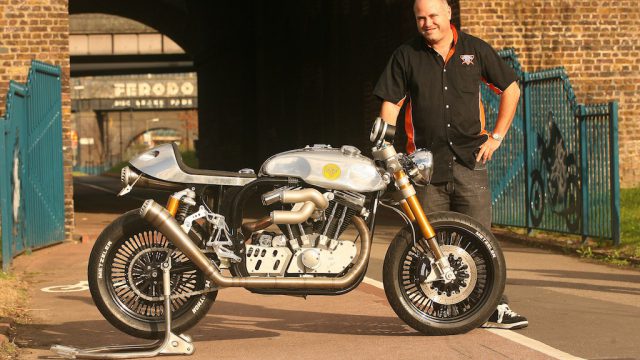
To construct the Café Racer, Gale began with a stock S&S air-cooled dry-sump motor, in this case the Wisconsin engine specialist’s ‘four-inch square’ 100ci/1650cc not-a-Sportster clone of Harley’s venerable but iconic pushrod 45º V-twin, similar to the S&S powerplant fitted to the French-built Avinton café racer. But this runs a much higher spec than either the Wakan or any Harley 1200 Sportster, with raised 12:1 compression, Crane Hi-4 CDI ignition with single-fire 12v coil, and a 1.85 in/47mm S&S Super E carb with sinuous spaghetti air cleaner intakes by NGCC, who also produced the satin alloy crankcase and transmission side covers. The result is quite a bit more horsepower than the 115 bhp Avinton – 138 bhp at the rear wheel at 5,200 rpm on the dyno, says Gale, with 115ft-lb/156Nm of torque at just 4,250 revs. This meaty motor is mated to a 6-speed Baker gearbox which the Michigan-based transmission specialist generously donated to the project, matched to a two-inch Evolution Industries belt primary, and a Barnett hydraulic dry clutch with aluminium basket, modified by NGCC to look good and work well.
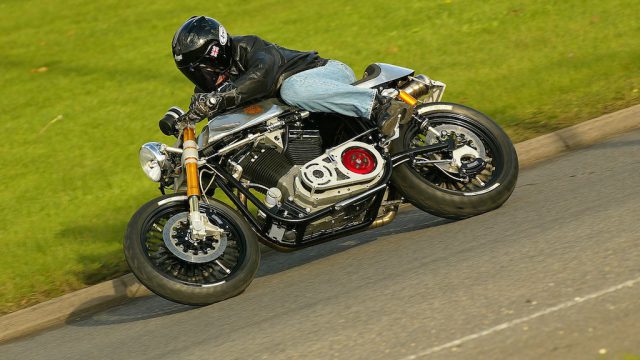
But when it came time to build the bike around this power-up package, Gale started not with the frame – but something else. “The wheels came first,” he laughs. “There was never a question as to what I was going to use – everything else came after them.” Looking at those neo-retro 50-spoke Fat Daddy wire-laced 18-inch rims from RideWright Wheels in California, shod with Metzeler Marathon rubber, you can understand why a modern Ace Café Racer had to have these – same as the so-called Super Wideline replica twin-shock Norton Featherbed chassis built by Sussex-based P&D Custom Bikes in Reynolds 531 chrome moly steel tube. Well – not quite a replica, though. “There was some miscommunication, and we got our wires crossed,” says Nick. “When I got the frame it was much wider than it was supposed to be, top and bottom, and there was no time to make another. Still, however unintentionally, this gave me the platform that I wanted to build a café racer on steroids, and not a traditional ’60s style retro bike as I’d been prompted to do originally. So it actually played very well into my hands.”
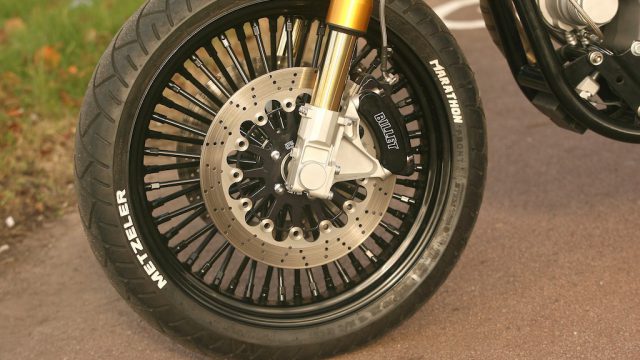
The result is a brawny, beefy, butch-looking bike displaying serious attitude, with 43mm Öhlins upside down forks gripped in specially made Harris Performance triple-clamps, with brake and clutch hydraulic master cylinders cleverly concealed inside the upper fork yoke for a clean look that’s aided by tucking almost all the bike’s wiring and cables inside the frame tubes. These forks are matched to twin piggyback shocks from the same Swedish sultans of suspension at the rear, with their trademark yellow springs replaced by black ones. Originally developed for a Z1000 Kawasaki, these have been fitted with 100mm/4in spacers to raise the ride height, resulting in a 51/49% forward weight bias to help the front 120/70ZR18 Metzeler grip the tarmac. With a trad-style tubular steel swingarm, wheelbase is a rational 1445mm by custom bike standards, with a 29º rake angle for those fully adjustable forks delivering 120mm of travel, fitted with Harris clipons with adjustable levers specially made for the bike. The Harris rearsets [footrest assemblies – AC] were originally destined for a Kawasaki ZX-10R, and have been modified by NGCC for use here.
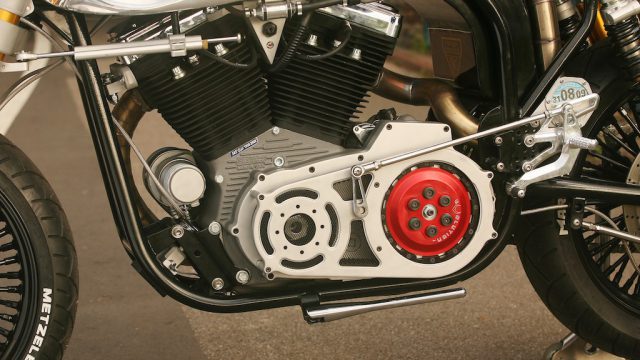
The Ace Café Racer’s 5½ gallon/24.5 litre aluminium Manx Norton fuel tank was tailormade by alloy craftsman John Williams at Scotland’s The Tank Shop to fit the chassis, and is just what Gale conceived the Café Racer as having from the very outset. “Again, the width of the frame enabled us to use that lowboy tank and have it look right,” he admits. “If it had been narrower, we’d have had to have gone up in height, which I really didn’t want to do. So to me that’s 100% as it should be.” The racing-style seat was also hand-beaten by Williams out of sheet aluminium, then bead-blasted like the tank for a uniform finish, and incorporates the rear lights countersunk into the metal – a further example of the minimalist mindset governing the Café Racer’s construction, resulting in a 198kg/436lb claimed dry weight for the bike. Hauling that down from speed are a trio of British-made Harrison Billet 11½ in/292mm floating steel discs gripped by the same firm’s four-piston radial calipers. “Fitting a front radial caliper at the rear meant turning it upside down, so we then had to re-etch the Billet sign the right way around,” says Nick. “But we’re running three radial calipers, so for a 200kg bike with a top speed of 160 mph-plus, it stops brilliantly.”
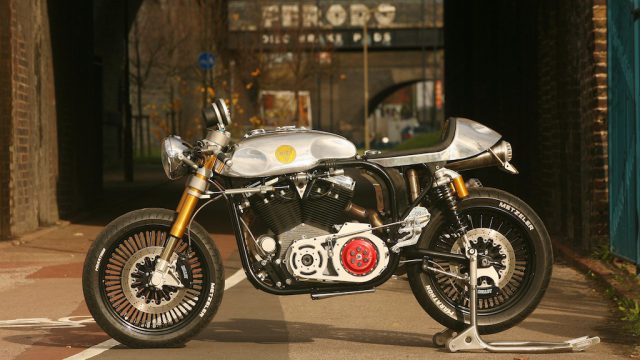
Building the Ace Café Racer entailed the usual detail problems Nick Gale and his team had to work round, starting with the oil tank for the dry sump S&S motor. “The one that was supplied to us was the size of a small country,” smiles Nick. “We’ve ended up with something much smaller that we knocked up here ourselves. It houses the battery, plus just enough oil for the motor.” Then there’s the fabulous-looking PowerPro stainless steel exhausts, which took ten days for Urbane Performance’s master fabricator the late Richard Bushell to weld up to MotoGP standards, complete with end cans right off the racetrack. This asymmetric system, with the pipe from the forward cylinder running along the side, and the one from the rear pot stuck under the seat, was chosen by Gale because “I wanted something that looked evil, and made the bike live up to the ‘Racer’ bit in the name.” But there’s also a clever variable flow feature aimed at killing dB at lower revs on what are pretty, er, free-breathing pipes. “When you first start the bike, there’s a spring-activated internal cone that reduces gas flow and back pressure,” Bushell explains. “As the gas pressure increases together with the revs, the cone reverses and opens up the gas flow, so the engine gets louder but especially more powerful.” Neat. Or how about that headlamp – very proper-looking. “It should be,” says Nick Gale. “It’s a ‘60s Triumph headlamp that came with an ammeter set into it. We decided we’d rather have an oil pressure gauge, so we replaced it with a Zodiac one. And I’ve used an AutoMeter Pro Drag tacho because it looks like that huge clock they fitted to Vincents back in the ‘50s – I wanted something big with a shift light and a memory, but we’ve broken a couple of them, so it needs to be rubber mounted.”
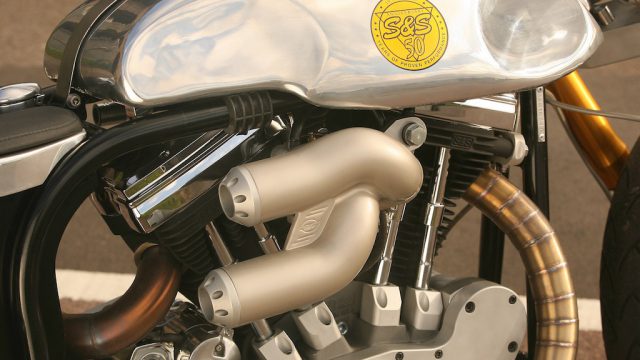
The disconnected tacho needle wasn’t the only thing I had to grapple with when I threw a leg over Gale’s show-stopping handiwork for a yesterday-once-more blat along the North Circular Road past the Ace Café, through the Stonebridge railway bridge arches still bearing the large-lettered advert for Ferodo brake pads that’s been there for the past sixty years, and over the Iron Bridge S-bend that, back in the Swinging ‘60s days of Mods & Rockers, used to have a sign before it warning of ‘Dangerous Curves’. For this was my run along Racer Road back then, when I lived just a couple of miles from the Ace Caff at Hanger Lane – and while my 250cc Ducati Mach 1 was pretty puny by the standards of the 650cc Tritons and 500cc Dresdas that the Rockers rode back then, it still kept up with them through the twisties, before getting out-gunned on the fast run down to Hanger Lane. No such problem today with the power-packed ticket to a ride down Memory Lane that is the Ace Café Racer, even if it wasn’t until joining the A40 for an 80-mile run out into the country that I fully appreciated just what an unlikely showbike this is – it goes like stink, and it’s fun to ride!

But alongside the serious reserves of power and torque available from the tuned S&S motor at just the twist of a wrist, the thing you’re most aware of first, last and always is how wide the Ace Café Racer is to sit on. The stretched-out stance is no problem – it’s a faithful modern interpretation of the typical Swinging ‘60s layout, where you stretched yourself flat on the tank to cheat the wind and gain speed, tucking your bum into the seat squab and above all, never hanging off – knee scrapers are a late-‘80s invention, remember! The Harris clipons were maybe set too flat – they’d be better off pulled back a bit, without sacrificing leverage, because the P&D frame steers really well, probably thanks to the skinny 160/60-section rear tyre Nick Gale has opted for, rather than a fatter 190-plus design statement so beloved of the Custom crowd. “I wanted the bike to handle, and the smallest tyre I thought could accommodate the power would be a 160,” says Nick. “We were very limited using the wheels that we had – they don’t make the Fat Daddys in 17-inches, 19-inchers looked wrong and were too big, 18’s were just right, and Metzeler produced the right tyre in a sporty enough guise, otherwise we were looking at Road King tyres which just wasn’t going to happen.” And those Kawa footrests really are rearset, and pretty high, too – no worries about ground clearance on the skinnier, fast-handling tyre.

So the only real problem is the width of the upper frame tubes, which not only dig into your inside leg, but also prevent even a 1.80m/5’’10” rider from touching the ground with both feet – toes, even. It’s not as if the seat is excessively wide, just that you can’t drape your legs well enough round the upper frame rails to touch the ground properly. Instead, you must plan ahead and make sure you get your right foot on the ground as you’re coming to rest at a stop light, because otherwise you’ll have to perform a stationary balancing act swapping from left to right with neither foot able to reach the ground, simply to reach the gearlever to select bottom gear to get going again. Mind you, there’s such mighty torque from that meaty motor that at least two of the six ratios in the Baker gearbox are totally superfluous, and you can actually leave the lights in third gear from rest, as I proved to myself a couple of times. Shifts nicely, too – Nick Gale was thinking of fitting a powershifter in future, which would make it even more of a hotrod than it already is.
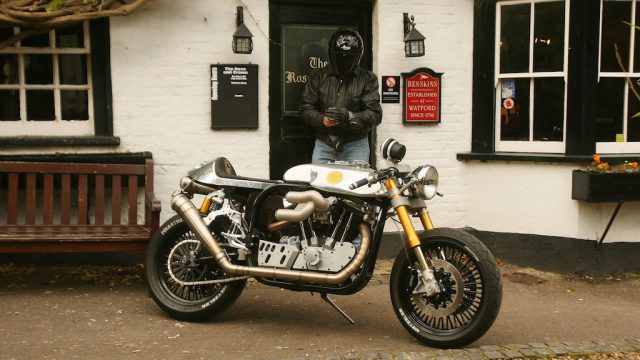
And that it is – even though when you thumb the starter and crank the solid-mounted motor into life, after groping around on the left of the motor for the hard-to-find ignition key, the Café Racer sounds positively mellifluous rather than rorty at the lazy idle speed the engine’s set to, with very little mechanical noise – there’s none of the low rent rattles and whirrs and tappety clicks you get from so many American V-twins. But that lazy throb is suddenly transformed into an angry roar once the engine’s warm and you dial up some revs, shoving the cones in the Urbane Performance exhausts wide open to let the power pour out. That’s when the Ace Café Racer starts living up to the name that Nick Gale and his guys at NGCC gave the bike after the first time any of them rode it – Little Miss Dynamite. Thanks to the lusty torque and super-flat power curve you don’t even need to rev it that hard off the line to get humungous acceleration and blistering performance– with no tacho I can’t tell you HOW little, exactly, but for sure not enough to make the motor start vibrating unduly, which it does begin to do if you wind it up really hard. In fact, it’s surprisingly smooth for a solid-mounted 45-degree V-twin without any counterbalancer – a joint compliment to S&S engineering and tolerance levels, the Baker transmission, and NGCC’s clever installation. The only negative was a graunchy takeoff from rest when you fed out the clutch, down to the absence of a gasket behind the starter motor, which let oil drop onto the plates, said Nick Gale. But the clutch action isn’t unduly heavy considering how much torque it has to handle, making this an improbably adept bike in traffic for something this meaty.

Yet in a way the most surprising thing about Little Miss Dynamite is that she’s Goody Two-Shoes when it comes to corners – in other words, Nick Gale Custom Cycles have created that unlikely thing – a showbike which handles. Maybe you’re in the wrong business, guys…. Seriously, the curious riding position doesn’t impact on what is a fine-steering package, with great grip from the Metzeler rubber when you use serious angle for hustling through turns right on the limit [see photos!]. Ride quality is amazingly good for a twin-shock motorcycle – there’s lots of compliance from the rear end, and you can feel the Öhlins forks soaking up road rash when you’re cranked hard over, giving lots of feedback from the front tyre, just as you’d expect from the Swedish suspension which their UK importers Harris Performance have dialled in good. And those radial Harrison brakes are outstanding – they haul the bike down from high speed very fast, but with lots of progressive response and no trace of snatch. The bike feels chunky and bulky to ride at low speeds, but as soon as you up the pace it miraculously seems to diminish in size, becoming easy to flick from one side to another down a winding country lane without feeling you shoulda gone to the gym to bulk up on muscle to heave it around. It’s pretty light-steering and very positive to place in turns, as well as displaying all the legendary stability of a Featherbed frame in faster bends. Job done.
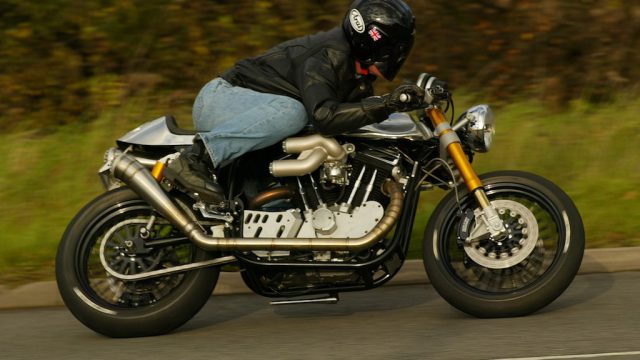
But hang on – this wasn’t about building a go-bike, but a show-bike. What happened, Nick? Turns out Little Miss Dynamite won Best Radical and Best in Show at the European HOG Rally in Italy, then appeared at Intermot in the Cologne Challenge, winning the Sportbike category. Yet this is yet another example of what had seemed of late to be a dying breed – one of the great British specials like the Dresda Triumph or Rickman Kawasaki or Harris Magnum or Spondon Yamaha or Tigcraft Honda. Bikes that stand out for their originality, while delivering outstanding performance and excellent handling – a motorcycle that swims against the tide of bureaucratic conformity. Well, in UK Custom circles, that’s just what the Ace Café Racer does – a showbike that’s been crafted with care, yet that’s an entirely practical ride for a Friday night cruise down the boulevard of your choice, or a Sunday morning scratch along Racer Road. Your call.
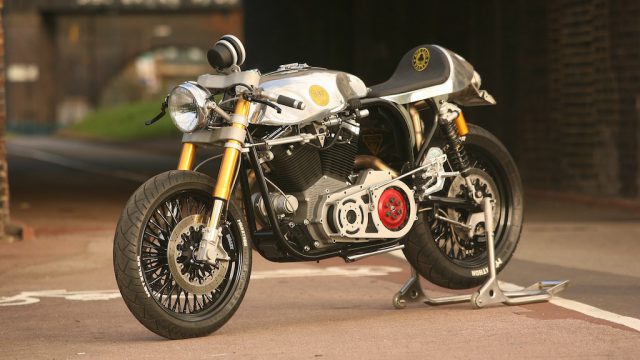
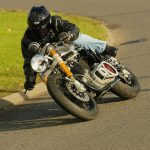
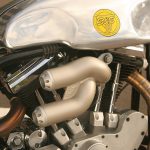
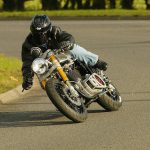
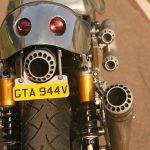
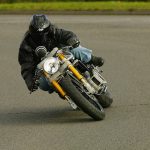
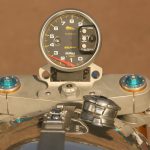
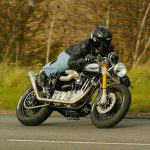
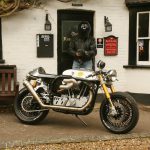
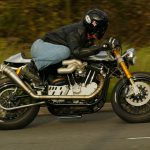
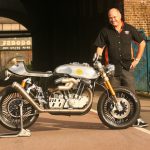
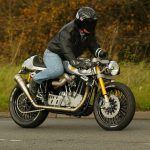
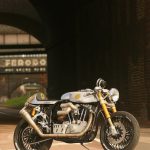
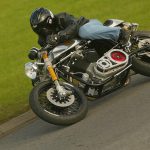
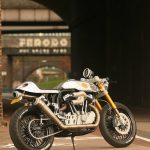
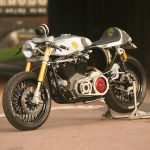
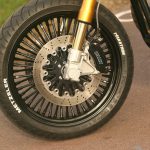
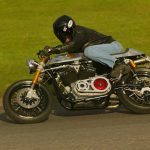
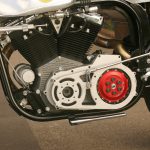
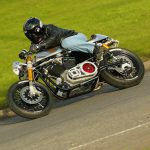
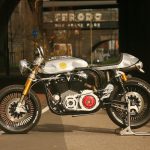
Great Bike, Jesse would have loved it. I am Jesse’s father so I should know. I have started a gofundme campaign to build the memorial in Sturgis, S.D. USA Please help spread the word to all his world wide fans search; Jesse Rooke Return to Sturgis 2022
Again this is a Great looking bike, thanks